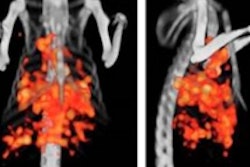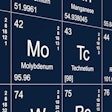Researchers have developed a new nanoscale agent that could potentially improve imaging of the gastrointestinal tract (GI), according to a study published online July 6 in Nature Nanotechnology.
Using a protocol that combines PET and photoacoustic imaging, the agent could be used to perform noninvasive functional imaging of the intestine in real-time, according to the group.
Weibo Cai, PhD, from the University of Wisconsin, worked with colleagues from New York and South Korea to develop nanoparticles that can provide good optical contrast for imaging, avoid absorption into the body, and withstand the harsh conditions of the stomach and intestine.
Currently, patients must drink barium for the intestine to be viewed using x-rays and ultrasound. With the new method, patients would drink a liquid that contains nanoparticles, enabling the intestine to be seen with photoacoustic imaging.
While photoacoustic techniques yield high-definition images, PET imaging can penetrate deeper and image the entire body. The combination therefore provides high-quality images with a view of the intestine in relation to the rest of the body, according to the researchers.
The group has successfully conducted studies in mice and hopes to move to human trials soon.




















